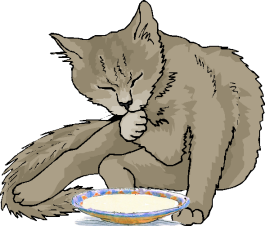Milk and cats - lactose intolerance

Despite the classic image from countless popular stories, a cat at a saucer of milk is not a match made in heaven. If a cat laps up a saucerful of milk, this may be because that is all the cat could get. In fact the poor creature might prefer almost anything else. It is not that milk is toxic to cats, but the digestive system of most cats canít really tolerate the stuff in any quantity. Thereís a reason for this. Not many creatures apart from westernized humans drink much milk after infancy, and even fewer creatures drink the milk of another species. Therefore a cat given a bowl of milk has a couple of biological hurdles to overcome.
All mammals start their lives by drinking milk. This is their first source of nutrition. However, for the digestive system to handle milk - or particularly to process milkís special form of sugar called lactose - the body needs to produce a special enzyme called lactase. (Lactose is a disaccharide - this means that it is made up of two sugars linked together - galactose and glucose. For mammals to be able to digest lactose, it has to be split into single sugars. This is the job of the lactase enzyme also known as Ŗ-D galactosidase.) Lactase is produced by the body as long as there is milk to be consumed. Usually once a mammal moves on to solid foods milk ceases to be a part of the diet, and lactase production stops. And once the body stops producing lactase, it never re-starts.
Because cats are naturally carnivores, milk has no part in the diet of a wild cat. Since these cats are never fed with milk or milk products their lactase production stops completely - which is why it is a bad idea to offer a feral cat a saucer of milk. The only cats which are lactose-tolerant are cats which have been fed milk on a moderately regular basis since kittenhood. If, as is probable, a feral cat has not had milk for a long time, its metabolism will probably be unable to cope with your kindly gesture.
'Probably' because as with humans, intolerance to dietary substances varies from individual to individual. Some cats, especially those which had a lot of milk while growing up, may still have some (though not much) lactase production going on in their bodies even after some time without milk. Yet other cats, even those with the same diet when young, may become violently lactose-intolerant.
Symptoms of lactose intolerance
After drinking milk, a lactose intolerant cat will suffer any or all the following symptoms: stomach upset, cramps due to painful accumulation of gas in the bowels, and diarrhea. This reaction is because the catís body is attempting to cope with food it cannot properly digest - somewhat as a human might experience similar symptoms from eating grass or unripe fruit. It is NOT an allergic reaction. With an allergy the body considers a particular substance as invading bacteria or a virus and mounts an immune response to that substance. As a result every new exposure to the allergen (that which the body reacts to) worsens the allergy which may in time become a life-threatening condition.
This is not the case with lactose intolerance. Once the lactose gone through the digestive system the catís symptoms will cease and the your cat will fully recover. Getting your catís trust back might take a little longer.
How do I know if my cat is lactose intolerant?
So what if you want to give a bit of milk to your cat as a treat but you are not sure if your cat is going to tolerate it? Start with a very small amount and watch for symptoms. If the cat does not have any symptoms and asks for more milk you can increase the amount slowly, waiting each time until you are sure that the previous dose of milk has passed completely through the digestive system.
Some cats like milk even though their digestive tract doesnít. For them there is specially formulated cat milk available in many supermarkets. This milk does not contain lactose. Nevertheless, there are two important things to remember. Many cat foods contain everything necessary to give your cat a balanced diet. A well-fed cat does not need a further rich source of protein such as that in the milk.
What is important is that your cat gets enough moisture, especially if she mainly consumes dried food. Fresh water will hydrate a cat better than milk - so if your cat shows a preference for milk, check that this is not because she needs a drink but is put off by the small of chemicals in tap water.
On the other hand, if a cat tolerates milk well, an occasional saucer of milk as a treat is not a bad thing. But remember that milk is packed with calories so any milk treats should be counted as part of the daily food intake.
What about other dairy products?
Most dairy products from milk to cream to cheese contain lactose in varying amounts. For example cream contains less lactose than milk (Which is why the cat that gets the cream looks especially smug.). Regular whole milk contains on average 4.8% lactose - whereas whipping cream has only 2.9%. Cats may tolerate cottage cheese and yogurt better than milk because in some dairy products certain bacteria digest the lactose. When it comes to other cheeses the amount of lactose will vary.
Hard cheeses usually contain more fat and less carbohydrates, which also means less lactose. Some cats develop a taste for moderately strong cheeses. Because it is sometimes possible to slip pills into the cheese (check with your vet), lactose tolerance can become a useful device for some lucky humans who find this a trauma-free way of medicating their pet.
The information supplied here is intended as a guideline only.
